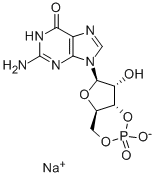GUANOSINE 3′:5′-CYCLIC MONOPHOSPHATE SODIUM SALT CAS#: 40732-48-7; ChemWhat Code: 97108
Identification
Physical Data
| Appearance | White powder |
Spectra
No data available
Route of Synthesis (ROS)
No data available
Safety and Hazards
| GHS Hazard Statements | Not Classified |
Source: European Chemicals Agency (ECHA)
License Note: Use of the information, documents and data from the ECHA website is subject to the terms and conditions of this Legal Notice, and subject to other binding limitations provided for under applicable law, the information, documents and data made available on the ECHA website may be reproduced, distributed and/or used, totally or in part, for non-commercial purposes provided that ECHA is acknowledged as the source: “Source: European Chemicals Agency, http://echa.europa.eu/”. Such acknowledgement must be included in each copy of the material. ECHA permits and encourages organisations and individuals to create links to the ECHA website under the following cumulative conditions: Links can only be made to webpages that provide a link to the Legal Notice page.
License URL: https://echa.europa.eu/web/guest/legal-notice
Record Name: (1-Cyano-2-ethoxy-2-oxoethylidenaminooxy)dimethylamino-morpholino-carbenium hexafluorophosphate
URL: https://echa.europa.eu/information-on-chemicals/cl-inventory-database/-/discli/details/213446
Description: The information provided here is aggregated from the “Notified classification and labelling” from ECHA’s C&L Inventory. Read more: https://echa.europa.eu/information-on-chemicals/cl-inventory-database
Other Data
| HS Code | |
| Storage | -20℃, sealed well and away from light |
| Shelf Life | 1 year |
| Market Price |
| Use Pattern |
| Sodium Guanosine-3′,5′-Cyclic Monophosphate (cGMP-Na) has several important applications in biochemistry, pharmacology, and biotechnology. 1. Signal Transduction Research cGMP acts as an intracellular second messenger, playing a critical role in various biological signal transduction processes, such as smooth muscle relaxation, vasodilation, and neural signaling. It is widely used to study guanylate cyclase activity and cGMP-dependent signaling pathways. 2. Pharmacological Studies Used to investigate the effects of drugs targeting cGMP-related pathways, such as treatments for hypertension, erectile dysfunction (e.g., mechanisms of phosphodiesterase-5 inhibitors), and cardiovascular diseases. Aids in new drug development and the evaluation of drug effects on cGMP-related processes. 3. Enzymology Research Serves as a substrate for cGMP-dependent protein kinases and phosphodiesterases, enabling studies of enzyme mechanisms and their regulatory functions. 4. Cellular and Molecular Biology Facilitates research on cGMP’s role in cell proliferation, differentiation, and apoptosis. Applied in cellular models or tissue culture experiments to explore signaling pathway regulation. |
Buy Reagent | |
| No reagent supplier? | Send quick inquiry to ChemWhat |
| Want to be listed here as a reagent supplier? (Paid service) | Click here to contact ChemWhat |
Approved Manufacturers | |
| Want to be listed as an approved manufacturer (Requires approvement)? | Please download and fill out this form and send back to approved-manufacturers@chemwhat.com |
Other Suppliers | |
| Watson International Limited | Visit Watson Official Website |
Contact Us for Other Help | |
| Contact us for other information or services | Click here to contact ChemWhat |


